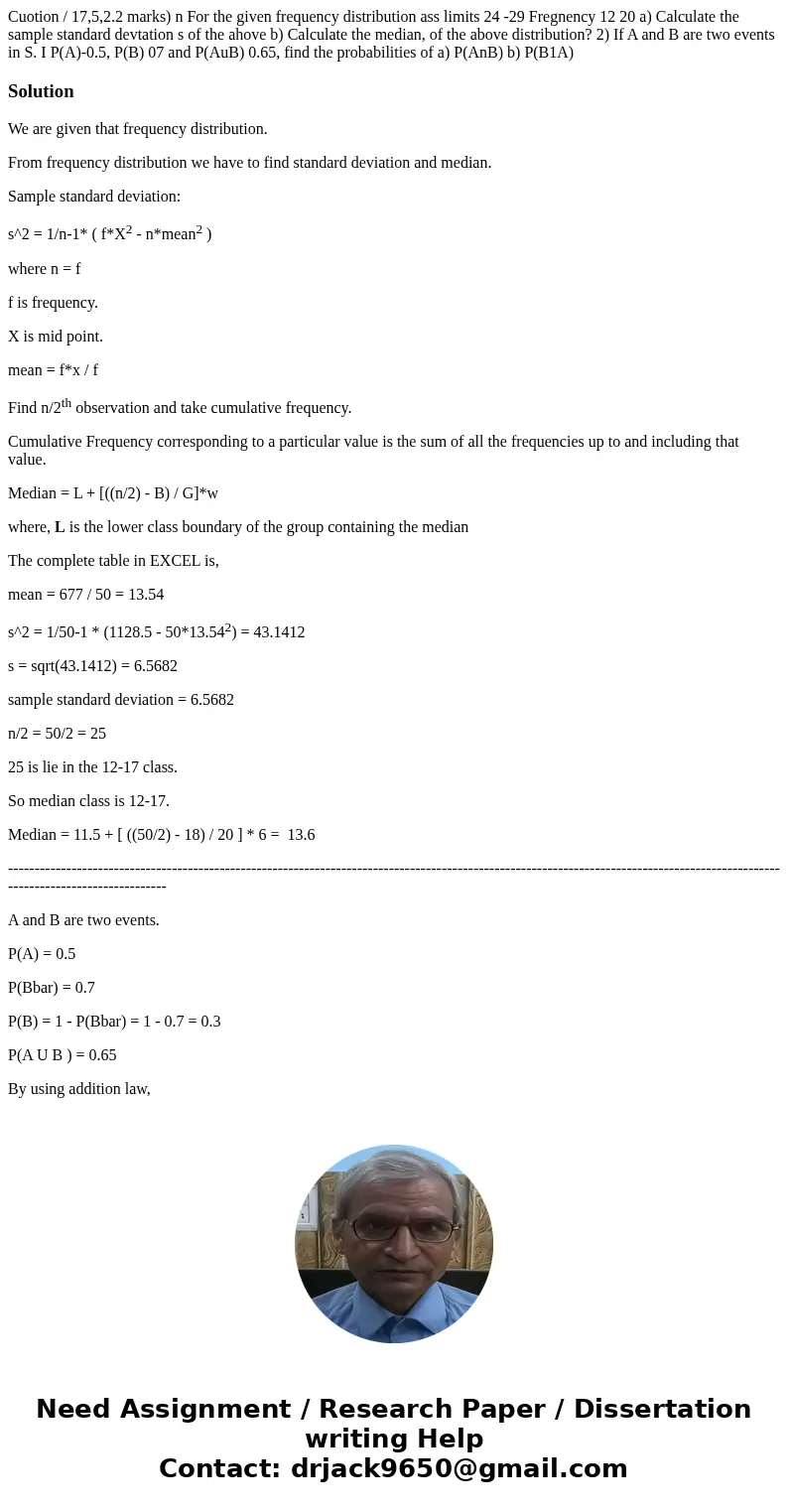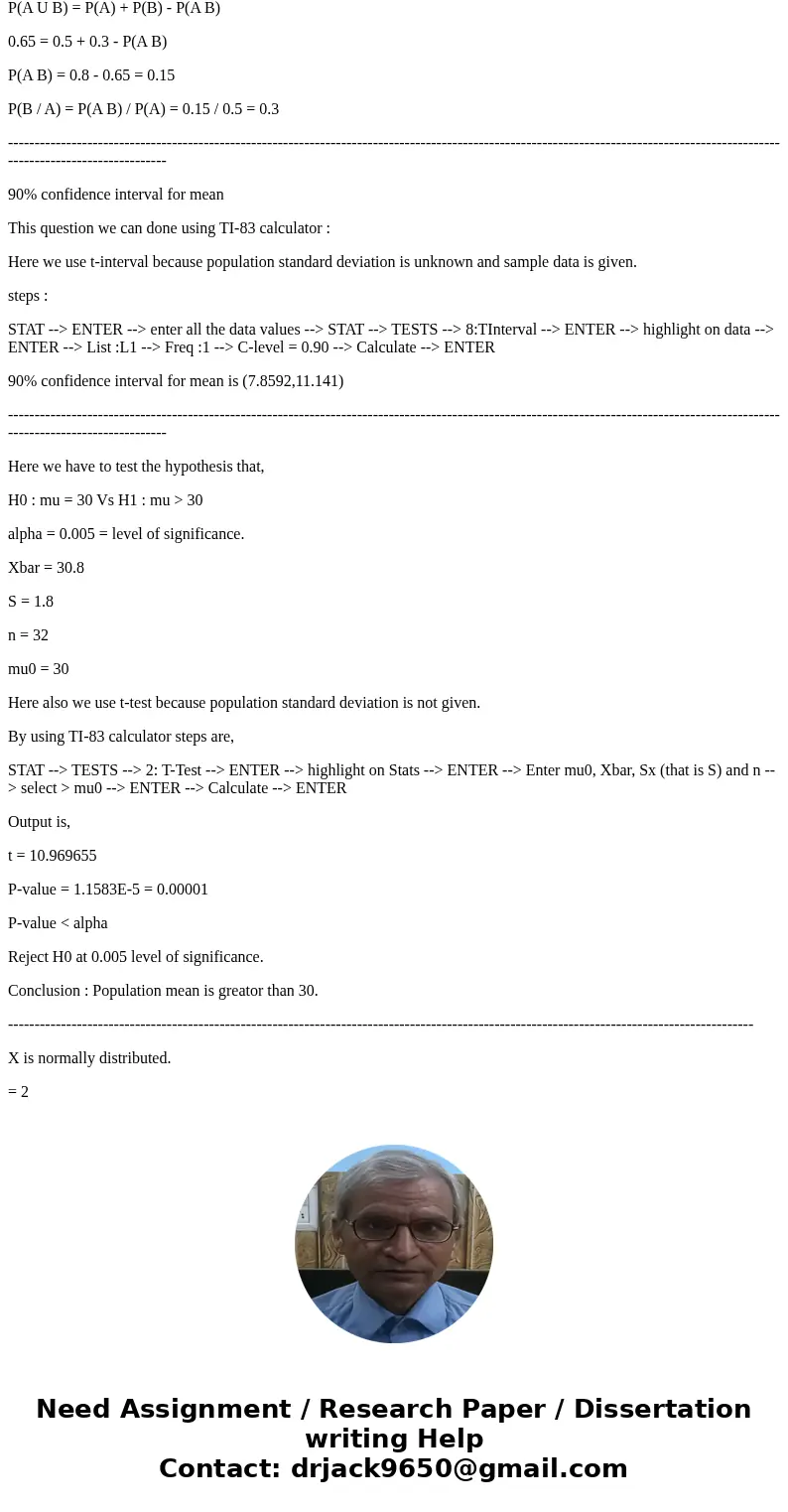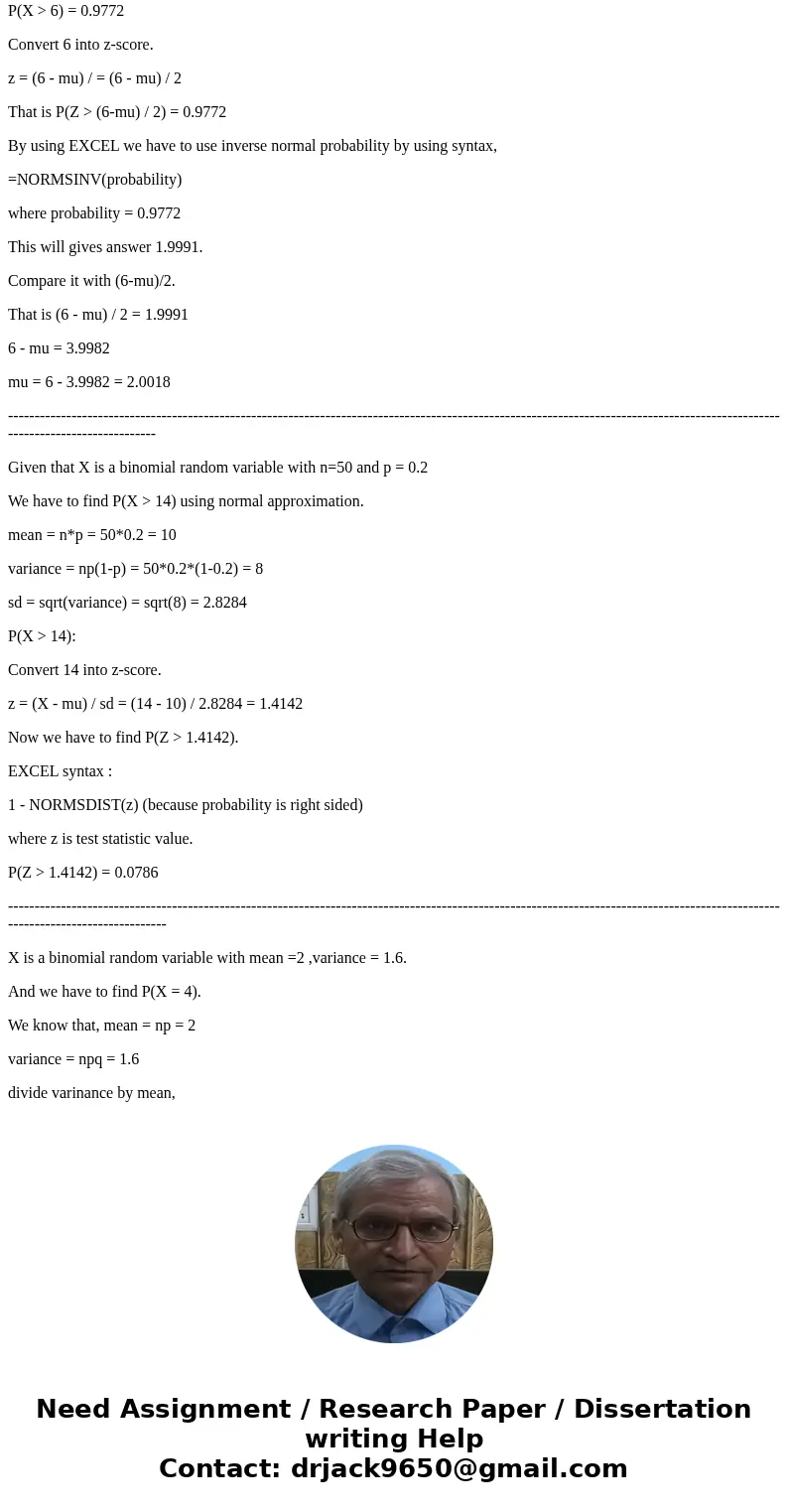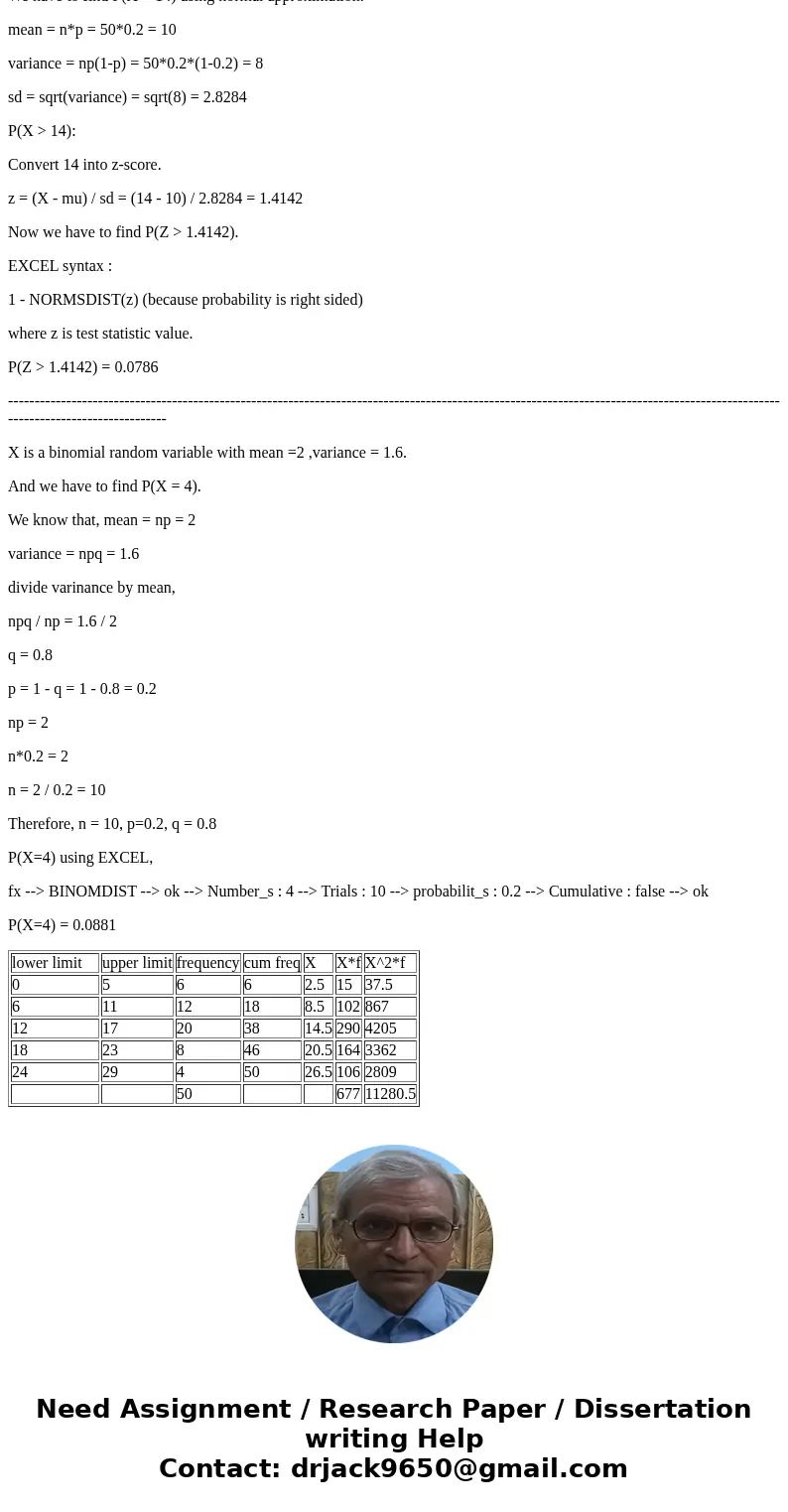Cuotion 17522 marks n For the given frequency distribution
Solution
We are given that frequency distribution.
From frequency distribution we have to find standard deviation and median.
Sample standard deviation:
s^2 = 1/n-1* ( f*X2 - n*mean2 )
where n = f
f is frequency.
X is mid point.
mean = f*x / f
Find n/2th observation and take cumulative frequency.
Cumulative Frequency corresponding to a particular value is the sum of all the frequencies up to and including that value.
Median = L + [((n/2) - B) / G]*w
where, L is the lower class boundary of the group containing the median
The complete table in EXCEL is,
mean = 677 / 50 = 13.54
s^2 = 1/50-1 * (1128.5 - 50*13.542) = 43.1412
s = sqrt(43.1412) = 6.5682
sample standard deviation = 6.5682
n/2 = 50/2 = 25
25 is lie in the 12-17 class.
So median class is 12-17.
Median = 11.5 + [ ((50/2) - 18) / 20 ] * 6 = 13.6
--------------------------------------------------------------------------------------------------------------------------------------------------------------------------------
A and B are two events.
P(A) = 0.5
P(Bbar) = 0.7
P(B) = 1 - P(Bbar) = 1 - 0.7 = 0.3
P(A U B ) = 0.65
By using addition law,
P(A U B) = P(A) + P(B) - P(A B)
0.65 = 0.5 + 0.3 - P(A B)
P(A B) = 0.8 - 0.65 = 0.15
P(B / A) = P(A B) / P(A) = 0.15 / 0.5 = 0.3
--------------------------------------------------------------------------------------------------------------------------------------------------------------------------------
90% confidence interval for mean
This question we can done using TI-83 calculator :
Here we use t-interval because population standard deviation is unknown and sample data is given.
steps :
STAT --> ENTER --> enter all the data values --> STAT --> TESTS --> 8:TInterval --> ENTER --> highlight on data --> ENTER --> List :L1 --> Freq :1 --> C-level = 0.90 --> Calculate --> ENTER
90% confidence interval for mean is (7.8592,11.141)
--------------------------------------------------------------------------------------------------------------------------------------------------------------------------------
Here we have to test the hypothesis that,
H0 : mu = 30 Vs H1 : mu > 30
alpha = 0.005 = level of significance.
Xbar = 30.8
S = 1.8
n = 32
mu0 = 30
Here also we use t-test because population standard deviation is not given.
By using TI-83 calculator steps are,
STAT --> TESTS --> 2: T-Test --> ENTER --> highlight on Stats --> ENTER --> Enter mu0, Xbar, Sx (that is S) and n --> select > mu0 --> ENTER --> Calculate --> ENTER
Output is,
t = 10.969655
P-value = 1.1583E-5 = 0.00001
P-value < alpha
Reject H0 at 0.005 level of significance.
Conclusion : Population mean is greator than 30.
---------------------------------------------------------------------------------------------------------------------------------------------
X is normally distributed.
= 2
P(X > 6) = 0.9772
Convert 6 into z-score.
z = (6 - mu) / = (6 - mu) / 2
That is P(Z > (6-mu) / 2) = 0.9772
By using EXCEL we have to use inverse normal probability by using syntax,
=NORMSINV(probability)
where probability = 0.9772
This will gives answer 1.9991.
Compare it with (6-mu)/2.
That is (6 - mu) / 2 = 1.9991
6 - mu = 3.9982
mu = 6 - 3.9982 = 2.0018
------------------------------------------------------------------------------------------------------------------------------------------------------------------------------
Given that X is a binomial random variable with n=50 and p = 0.2
We have to find P(X > 14) using normal approximation.
mean = n*p = 50*0.2 = 10
variance = np(1-p) = 50*0.2*(1-0.2) = 8
sd = sqrt(variance) = sqrt(8) = 2.8284
P(X > 14):
Convert 14 into z-score.
z = (X - mu) / sd = (14 - 10) / 2.8284 = 1.4142
Now we have to find P(Z > 1.4142).
EXCEL syntax :
1 - NORMSDIST(z) (because probability is right sided)
where z is test statistic value.
P(Z > 1.4142) = 0.0786
--------------------------------------------------------------------------------------------------------------------------------------------------------------------------------
X is a binomial random variable with mean =2 ,variance = 1.6.
And we have to find P(X = 4).
We know that, mean = np = 2
variance = npq = 1.6
divide varinance by mean,
npq / np = 1.6 / 2
q = 0.8
p = 1 - q = 1 - 0.8 = 0.2
np = 2
n*0.2 = 2
n = 2 / 0.2 = 10
Therefore, n = 10, p=0.2, q = 0.8
P(X=4) using EXCEL,
fx --> BINOMDIST --> ok --> Number_s : 4 --> Trials : 10 --> probabilit_s : 0.2 --> Cumulative : false --> ok
P(X=4) = 0.0881
| lower limit | upper limit | frequency | cum freq | X | X*f | X^2*f |
| 0 | 5 | 6 | 6 | 2.5 | 15 | 37.5 |
| 6 | 11 | 12 | 18 | 8.5 | 102 | 867 |
| 12 | 17 | 20 | 38 | 14.5 | 290 | 4205 |
| 18 | 23 | 8 | 46 | 20.5 | 164 | 3362 |
| 24 | 29 | 4 | 50 | 26.5 | 106 | 2809 |
| 50 | 677 | 11280.5 |




 Homework Sourse
Homework Sourse